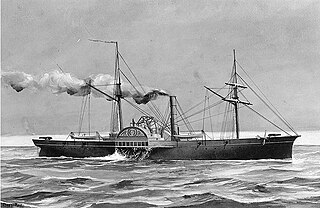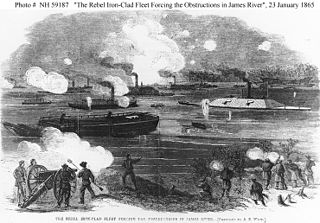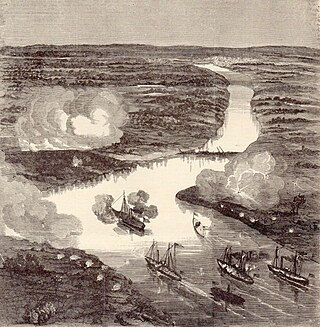CSS Scorpion was a Squib-class torpedo boat that served in the Confederate States Navy during the American Civil War. Armed with a single spar torpedo, she originally served guard duty on the James River after being built in late 1864. Along with the rest of the James River Squadron, Scorpion moved downriver on January 23, 1865, and participated in the Battle of Trent's Reach. After performing depth soundings near Union obstructions, Scorpion moved to get a lantern from the ironclad CSS Virginia II, but ran into a hawser and then ran aground. At 07:10 on the morning of January 24, Union fire struck the abandoned tender CSS Drewry, which then exploded. The force of the explosion swept Scorpion out of control downriver. An attempt to rescue her that night failed, and she was captured by Union forces.

CSS Patrick Henry was a ship built in New York City in 1859 by the renowned William H. Webb for the Old Dominion Steam Ship Line as the civilian steamer Yorktown, a brigantine-rigged side-wheel steamer. She carried passengers and freight between Richmond, Virginia and New York City. Yorktown was anchored in the James River when Virginia seceded from the Union on 17 April 1861 and was seized by the Virginia Navy and later turned over to the Confederate Navy on 8 June 1861.

CSS Virginia II was a Confederate Navy steam-powered ironclad ram laid down in 1862 at the William Graves' shipyard in Richmond, Virginia. Acting Constructor William A. Graves, CSN, was the superintendent in charge of her construction. In order to conserve scarce iron plating, he ordered the ship's armored casemate shortened from the specifications given in John L. Porter's original building plans; in addition, the ship's iron-plating, while six inches thick on the casemate's forward face, was reduced to five inches on her port, starboard, and aft faces. Due to the shortening of her casemate, the number of her cannon were reduced to a single 11" smoothbore, a single 8" rifle, and two 6.4" rifles.

John Randolph Tucker, an American naval officer who served in the navies of three nations. He was a commander in the United States Navy, captain in the Confederate States Navy, and rear admiral in the Peruvian Navy. As president of the Peruvian Hydrographic Commission of the Amazon, he contributed to the exploration and mapping of the upper Amazon Basin.

CSS Richmond was the name ship of her class of six casemate ironclads built for the Confederate States Navy during the American Civil War. Completed during 1862 the ship was assigned to the James River Squadron where she mostly supported Confederate forces near Richmond, Virginia. She was burned in April 1865 to prevent her capture by Union forces.

CSS Jamestown, originally a side-wheel, passenger steamer, was built at New York City in 1853, and seized at Richmond, Virginia in 1861 for the Virginia Navy during the early days of the American Civil War. She was commissioned by the Confederate States Navy (CSN) the following July, and renamed CSS Thomas Jefferson but was generally referred to as Jamestown, after Jamestown, Virginia.

CSSDrewry was a gunboat of the Confederate States Navy during the American Civil War. This wooden gunboat had a foredeck protected by an iron V-shaped shield. Classed as a tender, she was attached to Flag Officer French Forrest's James River Squadron sometime in 1863 with Master Lewis Parrish, CSN, in command.

CSS Raleigh was originally a small, iron-hulled, propeller-driven towing steamer operating on the Albemarle and Chesapeake Canal. She was taken over by the State of North Carolina in May 1861, and transferred to the Confederate States the following July. Her commanding officer during 1861–1862 was Lieutenant Joseph W. Alexander. Her entire service was in coastal waters of North Carolina and Virginia and in the James River as part of the James River Squadron.
The CSS Beaufort was an iron-hull gunboat that served in North Carolina and Virginia during the Civil War.
CSSHampton was a wooden gunboat of the Confederate States Navy, one of the few Hampton class gunboats to be built.

CSS Fredericksburg was a casemate ironclad that served as part of the James River Squadron of the Confederate States Navy during the American Civil War. Laid down in 1862 and Launched the following year, she did not see action until 1864 due to delays in receiving her armor and guns. After passing through the obstructions at Drewry's Bluff in May 1864, she participated in several minor actions on the James River and fought in the Battle of Chaffin's Farm from September 29 to October 1. On January 23 and 24, 1865, she was part of the Confederate fleet at the Battle of Trent's Reach, and was one of only two Confederate ships to make it past the obstructions at Trent's Reach. After the Confederate attack failed, Fredericksburg withdrew with the rest of the James River Squadron. On April 3, as the Confederates were abandoning Richmond, Fredericksburg and the other vessels of the James River Squadron were burned. Her wreck was located in the 1980s, buried under sediment.

William Augustin Webb was an American sailor and Mexican–American War veteran who resigned his United States Navy commission after more than 20 years of service to join the Confederate States Navy in the American Civil War. Webb was decorated for his service as Captain of the CSS Teaser, part of the James River Squadron, during the Battle of Hampton Roads (1862).

The Battle of Drewry's Bluff, also known as the Battle of Fort Darling, or Fort Drewry, took place on May 15, 1862, in Chesterfield County, Virginia, as part of the Peninsula Campaign of the American Civil War. Four Union Navy warships, including the ironclads USS Monitor and Galena, and the United States Revenue Cutter Service's ironclad USRC Naugatuck steamed up the James River to test the defenses of Richmond, Virginia, the Confederate capital. They encountered submerged obstacles, and deadly accurate fire from the batteries of Fort Darling at Drewry's Bluff, which inflicted severe damage on Galena, forcing them to turn back.

Drewry's Bluff is located in northeastern Chesterfield County, Virginia, in the United States. It was the site of Confederate Fort Darling during the American Civil War. It was named for a local landowner, Confederate Captain Augustus H. Drewry, who owned the property.

Joseph Nicholson Barney was a career United States Navy officer (1835–1861) who served in the Confederate States Navy in the American Civil War (1861–1865).

A Virginia State Navy existed twice. During the American Revolutionary War, the provisional government of the Virginia Colony authorized the purchase, outfitting, and manning of armed vessels to protect the colony's waters from threats posed it by the Royal Navy.

The Battle of Trent's Reach was one of the final major naval battles of the American Civil War. Beginning on January 23, 1865, a powerful flotilla of Confederate warships bombarded Fort Brady along the James River and engaged four Union Navy ships with the intention of breaking through the blockade to attack City Point, the base of General Ulysses S. Grant who was besieging Petersburg, Virginia. After two days of fighting, the rebels withdrew back up the river without completing their objectives.

Ebenezer Farrand was an American Commodore that served the Confederate States Navy and was notable for his service at the Battle of Drewry's Bluff as well as his ship construction at Selma, Alabama.

The Squib class torpedo boats were built for the Confederate States Navy during the later stages of the American Civil War. After the torpedo boat CSS David attacked and damaged the ironclad USS New Ironsides, the Confederates continued building torpedo boats with hopes of breaking the Union blockade. Four vessels of the class – CSS Hornet, CSS Wasp, CSS Squib, and CSS Scorpion – were constructed in Richmond, Virginia, in 1864. All were armed with a single spar torpedo and were powered by steam engines. Squib damaged the gunboat USS Minnesota in an attack on April 9, 1864, and was later sent to Wilmington, North Carolina, where she was scuttled in February 1865. The other three vessels of the class were all part of the James River Squadron and participated in the Battle of Trent's Reach on the night of January 23 and 24, 1865. Scorpion ran aground during the battle, and was forced downriver and out of control after the tender CSS Drewry exploded on January 24. She was later captured by Union forces and may have been burned. Hornet was sunk in a collision with another vessel on January 27, and Wasp was scuttled on the night of April 2/3, as the Confederates were abandoning Richmond.
















